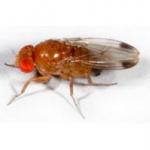Spotted Wing Drosophila
Drosophila suzukii
Spotted Wing Drosophila (Drosophila suzukii), SWD, is a recently introduced new species of fruit fly in the United States. It was first found on the west coast in 2008, but has rapidly colonized many fruit producing regions of the country. It was found in New England in late summer 2011 shortly after Hurricane Irene and caused significant crop damage in fall raspberries among other crops. While fruit flies (or vinegar flies) are nothing new in the US, this species is different in it's ability to infest healthy fruit. Other species typically infest over-ripe or damaged fruit. Females of this species have serrated ovipositors that can cut into healthy fruit to insert eggs. This can lead to problems with deteriorating fruit in the field or with customers who find multitudes of larvae in fruit after harvest. This insect has been devastating for fruit crops. Vegetable crops are less susceptible to damage, but greenhouse tomatoes and a few other crops may develop problems.
Identification:
The first step in dealing with this new pest is identification. Spotted Wing Drosophila is a small vinegar fly. Both males and females have red eyes. Males have two spots on their wings, which is a key identifying feature. Females lack the wing spots but have a robust and serrated ovipositor that distinguishes them from other species of fruit fly. Seeing the ovipositor requires some magnification; a hand lense will do.
Life Cycle:
- Overwinter as adults and maybe pupae in leaf litter, duff, and rotting fruit
- Adult flies live for up to 2 weeks
- Females can lay 300 eggs
- Can develop from egg to adult in as little as 8 days
- Likely to have over 10 generations per growing season
Crop Injury:
- Females lay eggs in fruit
- Larvae eat flesh, which renders it unmarketable or causes customer discontent (infested fruit ‘melts down’ in 2 days)
- Egg laying introduces fungal pathogens, which rot fruit
Monitoring & Thresholds:
- Use sticky cards inside traps or sieve contents to and check to confirm presence of SWD (males are easiest to see)
- Use hand lense and ID key to help with ID
- Record date and number of SWD caught to determine trend
Cultural Controls & Prevention:
- Unlike other fruit flies, SWD attacks sound ripening fruit
- Once eggs are laid in fruit, you will no longer be able to control with pesticides
- Short lifecycle and overlapping generations make spray timing difficult
- Requires sprays near harvest time
- Requires multiple sprays which can lead to pesticide resistance
Other resources
The Center for Agriculture, Food and the Environment and UMass Extension are equal opportunity providers and employers, United States Department of Agriculture cooperating. Contact your local Extension office for information on disability accommodations. Contact the State Center Director’s Office if you have concerns related to discrimination, 413-545-4800 or see ag.umass.edu/civil-rights-information.
